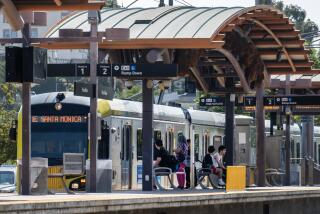Recruiting Drives MTA to School
- Share via
Marvin Diaz quit a $700-a-week job delivering magazines to learn how to drive a public transit bus. He excelled behind the wheel but flunked out of the training program.
The native Nicaraguan speaks English but had trouble reading and comprehending the test questions.
“It was a little confusing,” said Diaz, 38, of Sun Valley.
Los Angeles County transit officials, facing hundreds of vacancies, are now trying to help applicants such as Diaz acquire the basic English-language skills they need to become bus drivers.
They have teamed up with Los Angeles Valley College to create a free five-week vocational or “transit English” course in hopes of hiring more qualified immigrants.
“We believe there is an untapped market here,” said Stefan Chasnov, the Metropolitan Transportation Authority’s director of human resources.
The extra schooling is part of a broader recruitment effort.
MTA banners promoting driving as “a rewarding career” have appeared on 100 buses. And agency staffers are soliciting potential applicants at community meetings and job fairs.
Mayor Antonio Villaraigosa, who sits on the MTA board of directors, wants all the vacancies filled within the next six months. The agency is spending up to $5 million a year in overtime pay for veteran drivers who are working longer hours and extra days to keep the transit system running.
Villaraigosa will ask the board today to dedicate $50,000 to expand the new pre-training program and $10,000 for paying transit workers up to $300 for each new driver they recruit, with a limit of two paid referrals per employee.
“If we don’t get sufficient operators, we can’t operate all the services we have,” John B. Catoe Jr., the MTA’s deputy chief executive, said in an interview.
The MTA employs 4,200 full- and part-time bus drivers. But the agency must hire an additional 300 drivers to staff new bus routes and increased hours of service -- most mandated by a federal judge as part of a decade-old consent decree.
Attracting qualified applicants has been difficult, transit officials said. More than 3,600 people applied to be Metro bus drivers last year, but only 10% met all the requirements, which include passing drug tests and undergoing criminal background checks.
MTA officials cite the tight job market and increased competition from the security industry for their labor demand. Others blame relatively low wages, beginning at $13.36 an hour.
But Gloria Moore, executive director of the Wilshire-Metro Worksource center, which is helping the MTA recruit applicants, said the wages are competitive and the benefits excellent.
“For somebody with a high school education, that’s a good job,” she said, comparing it to wages paid to new postal workers, delivery drivers and airport security screeners.
In their search for new recruits, transit officials are targeting documented immigrants, now working in lower-wage jobs in hotels and restaurants, many without much chance for advancement.
Catoe described them as being “new to America.” He said, “It’s a workforce that’s demonstrated already their commitment to their employers.”
Andres Lunas, 44, never thought about driving a bus until a few weeks ago. He was looking for a job as a truck driver when he learned about the MTA openings at a Worksource Center.
“I don’t want to make a career out of being a security guard,” he said, with a thick accent. “I’m looking for progress.”
Lunas, a security guard earning $9.50 an hour, was one of 11 students in the pilot class that began Monday.
Most are older and were born outside the United States. To qualify, they had to meet basic job qualifications and test above the eighth-grade level in reading comprehension.
The course is a work in progress, said Douglas Marriott, outreach director for the Literacy Network of Greater Los Angeles, whose staff is preparing the curriculum and teaching the course.
Educators are using the MTA’s thick operations training manual as their guide. The course will emphasize study skills and customer service as well as reading comprehension, said Lennie Ciufo, Valley College’s job-training director.
MTA officials do not track the number of applicants who leave the driver-training program due to lack of English proficiency, but they believe the number is significant.
Transit agency officials said they have no plans to relax their rigorous hiring standards to meet hiring goals.
“It takes a certain level of English to be able to go through the training,” said Mark Anderson, the MTA’s training director.
Over the years, he has watched as applicants who spoke English as their second language fell behind in class and were forced out of the program. He has tried giving some of them more time to catch up.
“Given either a little bit better English skills and comprehension
Besides learning to drive, trainees spend four weeks in the classroom studying such matters as how to make a proper right turn, deal with disruptive passengers and recognize an explosive device.
Diaz didn’t have the benefit of the pre-training program when he fell behind in his classwork earlier this summer.
He says he would have passed the first time if he had been able to read English faster and been better prepared to tackle the transit agency’s study materials. He has lived in the United States for two decades but still prefers to speak Spanish at home.
Diaz spent two weeks studying on his own and re-enrolled in the bus driver-training program. He graduated earlier this month and is now driving a bus in the San Fernando Valley.
Now he faces a new career dilemma.
As a new driver, Diaz is working part time for the MTA and might have to get a second job to pay his mortgage.
“It’s tough,” he said. “If you can hold out for a year, you can make good money.”
More to Read
Sign up for Essential California
The most important California stories and recommendations in your inbox every morning.
You may occasionally receive promotional content from the Los Angeles Times.













